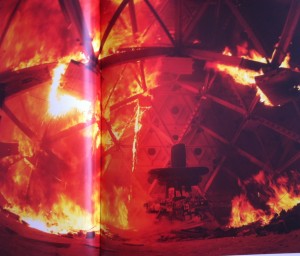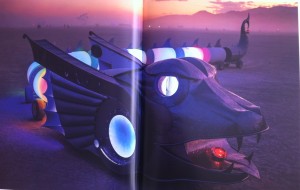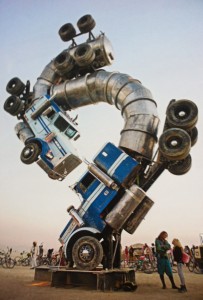
Burning Man – Art on Fire
by Jennifer Raiser with Sidney Erthal and Scott London
Race Point Publishing
Art of Burning Man
by NK Guy
Taschen
 Hallelujah! At long last, the art has made it into print and into world consciousness via two extremely well done books which will be viewed worldwide.
Hallelujah! At long last, the art has made it into print and into world consciousness via two extremely well done books which will be viewed worldwide.
Art on Fire came out last year in the U.S., and Art of Burning Man, published by Taschen, has just been printed in Italy for their global market, in English; French and German inserts are available for those markets. For the non-Burner, both books give a clear sense of both the art itself and of one’s experience of the art in its unique interactive state of being on the playa.
 NK Guy is both the writer and the photographer of Art of Burning Man, and has the distinction of being one of the few people who are very good at both. This book is the culmination of 16 years of shooting art on the playa, 1998 – 2014. NK’s breadth of on-site experience lends much depth to his book.
NK Guy is both the writer and the photographer of Art of Burning Man, and has the distinction of being one of the few people who are very good at both. This book is the culmination of 16 years of shooting art on the playa, 1998 – 2014. NK’s breadth of on-site experience lends much depth to his book.
His photographs are breathtaking and intimate; he’s a master of the capture of light and weather, achieving incredibly dramatic, high-impact shots. He deftly tells the tales of getting extremely difficult shots under duress; during whiteouts, high up on heavy machinery, and very close to massive fires. Not only do we see the art in his memorable photos, we also get a sense of what it’s like to experience these installations on site. Neil goes out early to the event, gets to know the artists and crews, and spends time witnessing the creation of these works as well as their destruction. Several artists are interviewed and NK also writes about the history, the ethos and the evolution of Burning Man. Far from artspeak, the writing is crisp and perceptive; Neil brings his own perspective and immediacy to this writing.
 I’ve been going for 21 consecutive years, and I learned a few things in NK’s history that surprised me, notably that the burning Man was on the back cover of the Whole Earth Review in the spring of 1991. In all my years of managing the archives, I never saw or heard mention of this. Larry’s explanation: the Whole Earth Review was considered “too hippie-ish” for the crew who started Burning Man, who likely never saw it; after all, this was the late’80s/early ’90s.
I’ve been going for 21 consecutive years, and I learned a few things in NK’s history that surprised me, notably that the burning Man was on the back cover of the Whole Earth Review in the spring of 1991. In all my years of managing the archives, I never saw or heard mention of this. Larry’s explanation: the Whole Earth Review was considered “too hippie-ish” for the crew who started Burning Man, who likely never saw it; after all, this was the late’80s/early ’90s.

In NK’s essay on Black Rock City’s physical aspects, I learned about grabens: “Northern Nevada resembles sepia-toned satellite views of parts of Mars — linear ranges of bare eroded peaks, separated by long flat valleys known to geologists as grabens; stretch marks on the body of the Earth.”
I also learned that the trash fence runs for 9.2 miles. NK has my admiration for using the word “palimpsest” — look it up! (Hint: it’s the literary equivalent of pentimento in painting). Thanks, NK!
 NK has managed to take some previously uncaptured photos: an aerial photo of the city taken at night when NK joined the Burning Sky team in 2009 on a rare after dark skydiving flight, typically not allowed by the airport. He also got a heroic shot of the interior of 2013’s temple burning, achieved by attaching a cable to a digital camera inside the temple, standing close to the burn for as long as he could stand it, then yanking out the camera. In the shot you can see the accelerant pouring down from the ceiling as everything bursts into flame — incredibly dynamic photography.
NK has managed to take some previously uncaptured photos: an aerial photo of the city taken at night when NK joined the Burning Sky team in 2009 on a rare after dark skydiving flight, typically not allowed by the airport. He also got a heroic shot of the interior of 2013’s temple burning, achieved by attaching a cable to a digital camera inside the temple, standing close to the burn for as long as he could stand it, then yanking out the camera. In the shot you can see the accelerant pouring down from the ceiling as everything bursts into flame — incredibly dynamic photography.

The layout of the book is visually stunning; in many cases the photos are full page bleeds, two page spreads or multiple page pullouts. The vast scale of the desert seems to demand large photographs, and we certainly get them here. The book is organized in a clever manner — the introduction to all things Burning Man is followed by Morning, Afternoon, Evening, and Night sections, which very neatly categorizes the art without being pedantic.

The strength of NK’s book, apart from the remarkable photographs, is the fact that the photographer is also the writer, and we are treated to stories of the difficult realization of huge installations in a hostile environment, and some very tricky photographic situations. It’s fascinating to learn how certain photos were achieved, and how some of the art was built. Overall you really get the sense of being there — and how deeply experiential the art is, thanks to NK’s firsthand accounts of his shooting adventures.

Art on Fire covers playa art from 2004 through 2013 via Jennifer Raiser’s perceptive writing and her many discussions with the artists, complemented by photographs by Scott London and Sidney Erthal. Jennifer, a Burner and a Black Rock Ranger, also covers the history and background of the event, and writes about the art as a phenomenon produced by a generous and expressive community of like-minded souls. She has interviewed many of the artists, and we’re treated to their histories and perspectives on the experience of art-making in such an extreme and challenging environment, as well as Jennifer’s views on this body of work.

The book is structured by categories of art: monumental art that seems impossible to build; mutant vehicles, collective art built by large crews, technology-based art, spiritual art, and art that incorporates flame effects or is built to burn. The focus here is squarely on the art and the artists.

Together, these two books present an astute picture of the art of Burning Man and all of its attendant culture-making and community building. We’re given both a critical perspective on the art by Jennifer and the many artists she interviewed, as well as a deeply experiential history of Neil’s adventures photographing this art for 17 years. The reader who has never attended our event will come away with a solid sense of the art, the artists and the culture of Burning Man. For experienced Burners, the art we’ve so loved and enjoyed over the years is beautifully captured in both books, evoking memories of our playa experiences. We also learn about the history and culture of each installation via stories from the artists, as well as the authors.

I’d recommend that everyone get both books, for a complete look at the art, the artists and the difficulty of creating and photographing this work. These two books are absolutely complimentary and together show the world the incredible body of work that Burning Man has inspired, the commitment and vision of the artists and crews, and the unusual setting, outside of the commodified art world. I believe these books will be eye-opening and inspiring to many people who have not been to the event, and will spread the culture of Burning Man far and wide. BRAVO!!!!


As a 21 year Burner myself, I have to admit NK Guy’s Art of Burning Man is the best book I’ve seen so far to actually capture the feel of the playa. I received my copy just before heading to the 2015 event….my excitement reminded me of the feeling I had back in mid 90’s when the seminal Wired book came out!
Report comment
Yes Eggy, Wired got our Blinkingmancamp out there in ’97…….looks like with this book a few Xmas gifts will be easy to cross off……Thanks LadyBee for the heads up
Report comment
Hello! A wonderful man took some pictures of my life partner and me out by the trash fence this past year. We sadly have forgotten his name, it is possibly Dennys, but he gifted us these Blinking Man little hexagonal tokens. We talked for quite a while about his amazing trash fence art SLRT Camera installations. We are attempting to track these photographs down. If you know of any information that could help that would be fantastic! Thank you!
Report comment
SHellord – A quick look through the 2015 art installations page yields this: http://burningman.org/event/brc/2015-art-installations/?yyyy=&artType=B#SLRT
SLRT by: denny smith
This year’s project will be the sixth out on the perimeter phence past the Man and the Temple. Once again, BlinkingMan Camp (’97) will surprise visitors to the deep playa with a little something on the phence – Cameras this year. Each will be adorned with recycled and random items. The cameras themselves do not work – they were heading for a landfill. Friends adopted some of them and their point of creative view adds to the eclectic “yard art” nature of this project. Every camera has a unique theme with a hidden meaning! Perhaps you discover it or you connect your own meaning to enjoy the visit. The deep playa is a gem, the citizens of the city that visit are rewarded with views and sounds many accidentally eschew. Please take a photo with your personal favorite and send it to me. After the event I will include it in a slideshow to be shared with the community. SLRT, where you capture an image of one of Black Rock City’s special places.
URL: https://vimeo.com/132514581
Report comment
You’re most welcome!
Report comment
Nice review, Ladybee! As a geologist I was slightly taken aback when I read that you learned a graben is a valley. Instead, think of a graben as a block of Earth’s crust faulted yielding downward movement and caused by crustal extension. It may yield a valley, but it’s a faulted block first and foremost. If it were faulted in an upward movement that was cause by crustal compression, it would be called a ‘horst’ Alternating ridges and valleys of horsts and grabens make up much of the Basin and Range physiography of Nevada.
I also agree that Scott London’s photos are awe-inspiring, not only of the art but of the people surrounding Burningman.
Overall, thanks for a solid review.
Report comment
Gosh, thanks Rhino! Both NK and I stand corrected!! and educated, thanks to you!
Report comment
Comments are closed.